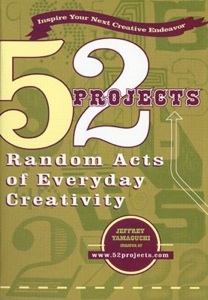52 Projects by Jeffery Yamaguchi

by Matt Hanson
originally published in Flak Magazine
Jeffery Yamaguchi's 52 Projects is the type of pocket-sized, quasi "self-help" book you often see strategically placed among the espresso machines, ceramic doodads, and trendy world music in your local coffee shop, offering instant karma to the already over-caffeinated Da Vinci-on-the-go, a collection of ideas, projects and suggestions intended to stimulate creative impulses in everyday life.
You could see this type of book as either a refreshingly earnest and sweet-natured gesture, or a pathetic pile of saccharine corn and cheese, depending on your preferences and how pretentious you are. As newly-honored Philip Seymour Hoffman once said, while portraying the brilliant Lester Bangs: "Coolness is the enemy of art." This book is not cool, and it's not even really trying to be; and that's what's so weird and nice about it.
Perhaps it's for this reason that Yamaguchi's book is pretty easy to mock. It indirectly appeals to the inner snob. Its guileless premise gets the same eye-rolling groan that refuses "Chicken Soup for the Soul." But as anyone who's tried to work toward inspiration knows, snickering condescension and apathy do not an artist make.
Some of the better propositions Yamaguchi has to offer concern historically creative subjects: writing, drinking and photography. Some are luminous, such as Number 12: "Take some pictures of your lover while he/she is sleeping. Then, write down some dreams, frame the photos and the dreams, or make a little book out of them." Some are oddly poignant, as in #39: "Go someplace, alone. Once you are there, take a picture of yourself, using your camera; Immediately after taking the picture, leave, and never go back. Ever." Many have to do with drinking: "Make the perfect margarita, try it two or three or four times; shotgun a beer or two with an old high school buddy, like you did back in the day ... pop champagne when you get bad news ... why does champagne have to be all about the good times?" It's interesting that the project advising shotgunning brewha's follows chronologically the lyrical approval of writing down your dreams and sharing them with your lover.
Others are nice, but more pedestrian: Buy inexpensive art and hang it all over your apartment. Try to write down the exact circumstances and history of your first arriving at the place you currently live. Find your old letters, read them, have a Proustian experience of remembering things past and previously forgotten. Number 23 has a nice cinematic edge to it: "Document the life of the party. Take a picture of the main room before anyone arrives, another when the party is in full swing, and then another after everyone has left. Frame the three photographs in sequence." Part of the meaning of these exercises is that they begin to get your mind out of the usual rut and start thinking differently. In this vein, he suggests going to the library and finding the books shelved alphabetically before to the ones written by your favorite author. Idea number 21 is to take a picture of the same place at the same time every day for a month. Put the pictures in chronological order and observe the miniature, complex stasis of objects surrounded by the rest of the world and within the flow and swirl of time. Paul Auster wrote a very short story a few years ago based partly on this premise, with surprisingly lovely and haunting results.
The flipside to the drinking and photography is Yamaguchi's occasionally bizarre and downright Dadaist pointers on the art of coaxing creativity from its shell. After a party, leaving money and a handwritten note under the hosts' pillow might be a sweet and thoughtful gesture, but not exactly creative. Is it too paranoid to consider it somewhat creepy? The same goes for saving chards of accidentally broken glass, or taking pictures of your friend eating a key lime pie. Number 28 is a Dali-esque hoot: Collecting random broken umbrellas after a rainstorm and giving them a proper burial is certainly evidence of something, but I don't know exactly what. Making a cake with something random on the top like "Here's to more closet space!" or "Don't Fuck with Chuck!" (Number 43, if you're keeping track) might make you a little creative, but will guaranteed decrease the old social life. The piece de resistance is number 42 (with all symbolic meanings of said number very much in place), which is worth quoting at length:
"Take some chopsticks from your kitchen drawer, and along with $25 cash and a take-out Chinese food menu, seal them up in an envelope; mail off this envelope to a currently unemployed friend. Keep it anonymous. Do not hand-write the mailing address or enclose a note."
When all is said and done, this book may very well strike the match of inspiration for plenty of people. If it can teach the fine art of living innovation to a multitude of hesitant souls, far be it from me to mock or condemn. If, at project's end, you still think you're too cool for school, you can always fold the pages into origami.

